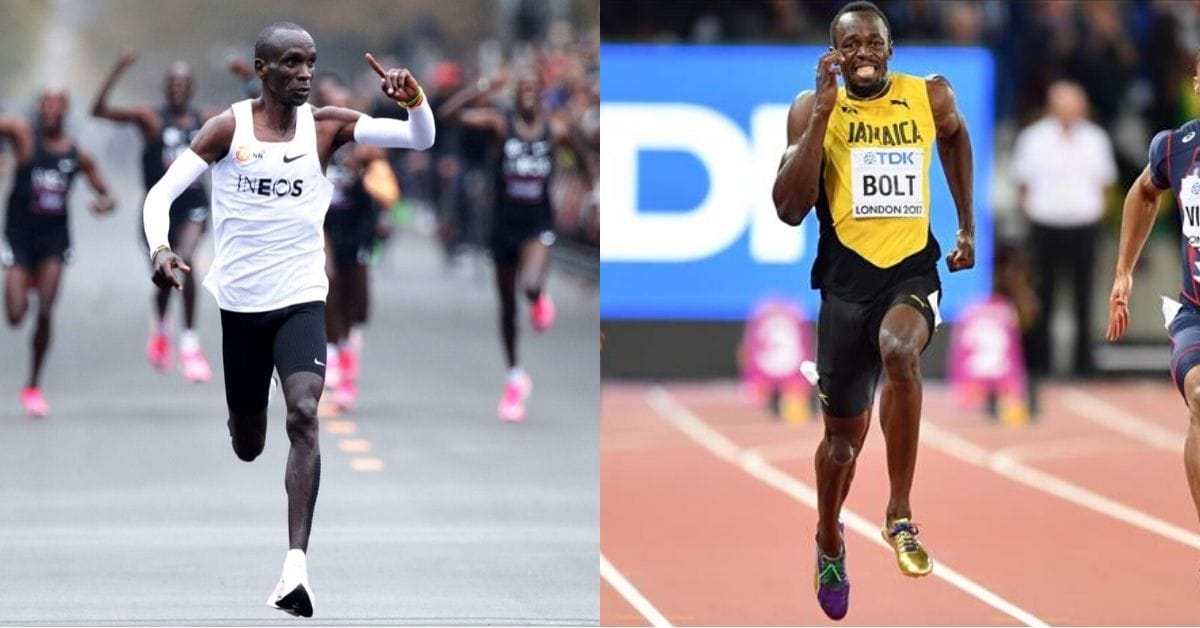To Know Where to Start, You Need to Define the End
If you were told to train for a run, how would you train? Would you train for stamina and long distance? Or would you focus on speed over a short distance? Would you train for a specific running surface or varying elevation? Would you train expecting to run in the rain or the sun, the hot or the cold? Without defining run, it's possible to know.
When runners run, they craft everything they do around the finish line. Sprinters train for short distance, focusing on power and running as fast as they possibly can. Marathoners train for long distance, not how fast they can run, but how fast they can run for 26.2 miles. The difference in their training and their skillset is visually obvious.

Usain Bolt and Eliud Kipchoge both won gold medals at the 2016 Olympics in running. Bolt in the 100m, 200m, and 4x100m relay, and Kipchoge in the marathon. You can see Bolt's power, his muscles are bigger and more defined, which allows him to run entirely differently than the marathoner. Kipchoge is less obvious, not replying on speed, but instead on endurance and stamina, that's why he can be the best at what he does with a less intimidating physique.
In both cases, because they know where the finish line is, either 100m or 26.2 miles away, they can make decisions that will give them the best chance for success. Here's Bolt's training, and Kipchoge's training. They are worlds apart. Bolt focuses on high intensity exercises and explosiveness. Kipchoge just does low intensity runs, with a weekly goal of over 200km.
I draw a lot of similarities to how we approach our retirement. A lot of us go through life knowing that we have to prepare for retirement, but without really defining what it is. It's a hope for the best sort of strategy, without a defined finish line in the future. It's like being told to train for a run, and hoping that it's whatever you're best at.
Since running races can take so many different forms, and cover a wide range of lengths, a lot of the success comes from knowing what kind of race your running. By defining our retirement, we can know exactly what we are working towards, and we can take the proper steps along the way to prepare for it.
Key Takeaways:
- Like running, driving, or completing a task, it's only possible because we have a finish line in mind – we need a finish line for our retirement.
- Defining our retirement is tough, you don't need to already have all the answers – you just need to start thinking about it.
- Defining when you want to retire and what you want it to look like, allows you to work backwards to figure out the how.
“Many problems can’t be solved forward.” Charlie Munger
Approaching the task of preparing for retirement, without first defining your retirement, is a lot like preparing for a run without knowing the specifics of the race. It leaves you in a position of guessing, without knowing what the first step is, and hoping that you'll be okay in the end.
Thinking about retirement can be very overwhelming, and if it's still decades away, it can feel like a waste of time when there's more pressing concerns in the present. The good news, is there's only two things that we really need to think about to get clarity on our retirement: when and what.
Defining When
A simple place to start, is defining when you'd realistically like to retire. Generally, most people retire at age 65, but that in itself, isn't a good enough reason to pick age 65. Have a justification, not a default.
If you have a pension, you can take a look into when your full benefit would be available to you. Depending on your expected sources of income during retirement, you could look at what your government benefits (like CPP and OAS) would be and when they'd kick in.
Defining when, might also take some revisions. Very likely, there will be a gap between where your pension and government benefits will take you compared to your ideal retirement. This gap will need to be made up of additional contributions. Depending on what's realistic, your target retirement date could move around based on what you're regularly able to contribute.
Defining What
Next is thinking about what your ideal retirement looks like. To help get the juices flowing, I like to ask: What would you do if money were no object? It's an exercise that should be thought of as a dream situation, while being realistic (a more comfortable lifestyle than now, with the freedoms to do what you like, but not buying 10 cars, 5 houses, a private jet to get to your island, etc). There's really two big things we want to identify:
- Your bucket list items, the things that you want to do the most. This could look like: travelling, buying your dream home, going on an adventure, or whatever gives you the most joy.
- It's impossible to constantly be checking things off your bucket list. So you also need to identify how you'd spend your time when you're not doing those things. This could look like: doing what you do now (or at a reduced capacity), starting a business, volunteering, focusing on hobbies, or whatever gives you the most purpose.
Happiness isn't created by external things, but is instead created internally within each of us. That's why it's important to focus on experience, meaning, and purpose to not only enjoy our time, but get happiness in our day to day. Create a life you don't need a vacation from.
Another thing you can try, is to think of your funeral and what you'd hope someone would say during your eulogy. What values or accomplishments would you hope that they speak about? This can help put our current actions into perspective (no one will say that they wished a loved one worked harder, spent more time at the office, or spent less time with their family). Align your actions with the person you hope to be.
These are big questions, so don't worry if you don't have an answer right away. The problem is that we hardly spend anytime at all thinking about these things. The idea here is to get you thinking, and over time define what an ideal retirement looks like to you.
Figuring How
Once you know when you realistically want to retire and what your ideal retirement looks like, it's all about figuring out how to make it happen.
As I eluded to earlier, you may find that a pension and government benefits only get you so far. A big reason is because everyone has different financial obligations and aspirations. If we imagine two coworkers who spend their entire career with the same company, earning the same income, and accumulating identical pensions, it doesn't take much imagination to think of how their situations could be different.
Your retirement income shouldn't be based on how much money you made, it should be based on how much money you need.
By understanding how much you'll need, you can work backwards to figure out what effort you need to get there. Let's say you need to accumulate enough to provide an income of $100,000 during your retirement. If your pension and benefits provide $75,000, that leaves a gap of $25,000. Depending on your time horizon, and risk tolerance, you can figure out exactly what you'd need to contribute between now and retirement in order to close that gap.
With investing, time is our best friend. The earlier we begin to take the proper steps to ensuring that our retirement is secure, the easier it is to get the results we hope for. And instead of hoping, we're actively making it happen.
Just like a runner defining a race they are planning to run, to ensure they take the proper steps to prepare for it that gives them the best chance for success, we can do the same with our retirement. By defining when we want to retire, and what we want our retirement to look like, we can craft a training plan that shows us how to get there.
Your retirement is too important to leave up to chance.
Keep doing things your future self will thank you for.






Member discussion